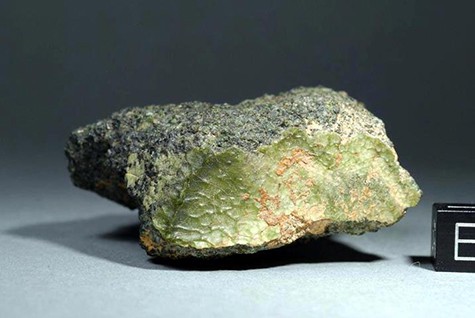

Early in 2012, someone in Southern Morocco picked up 35 greenish stones. Purchased by a dealer in Erfoud, Morocco, one of them was then resold to Stefan Ralew, a meteorite collector from Berlin.
The dealer was demanding a high price, and Ralew may have hesitated. But the wrinkled glassy coating on one face of the rock was clearly a fusion crust, a kind of glaze that forms when a meteorite is heated as it passes through the atmosphere.
Looking at other faces, he would have recognized it as a type of meteorite called an achondrite, says Randy Korotev, a meteorite expert at Washington University in Saint Louis (WUSTL). That meant it was an exceptional stone.
Most meteorites are stony, he explains, and of the stony meteorites, almost all (90 percent) are what are called ordinary chondrites. These are pieces of small, unmelted asteroids that are uniform in composition throughout.
The achondrites, on the other hand are pieces of large asteroids or planets, ones at least 200 kilometers in diameter. These produced enough internal heat early in their history to partially melt and segregate into a metal core surrounded by a rocky exterior. Achondrites, which come from the crust or mantle of these differentiated bodies, make up only 5 percent of the stony meteorites that have been found.
So already this find was looking very interesting. Where might it be from? About half of the achondrites come from the large asteroid 4 Vesta. Others come from Mars, the Moon, or other asteroids.
To answer the question of origin, the stone’s chemistry had to be analyzed. Ralew shipped it to Tony Irving at the University of Washington. “Tony is where all the serious collectors go when they find strange meteorites,” says Korotev, to whom Irving sends the “lunars” (possible lunar meteorites), which is what Korotev mainly studies.
Both the iron/manganese ratio of an asteroid and the ratios of its oxygen isotopes (variants of the oxygen atom) are thought to serve as “fingerprints” of its body of origin.
At the 44th Lunar and Planetary Science Conference in March, Irving said that the stone, now officially designated Northwest Africa 7325 (NWA 7325), had highly unusual chemistry. What’s more, he said, the chemistry was suspiciously similar to that measured by NASA’s Messenger probe, which is currently surveying the surface of Mercury from orbit.
“It is high in magnesium and very low in iron, which is what they’re seeing on the surface of Mercury,” Korotev, who attended Irving’s talk, says.
Some chemical ratios didn’t match, but Irving said that might be because the stone had been “excavated from depth,” that is, blasted into space by a collision that left a deep scar in Mercury.
Although Korotev can’t say for certain where the meteorite comes from, he can say why it is such a peculiar green. The green comes from a silicate mineral laced with chromium.
“I once analyzed bottles to see what made them blue or green,” Korotev says. The greenest bottle had 660 parts per million chromium, but some of the mineral components of NWA 7325 have 7,000 parts per million chromium. That’s why it’s green.”
But the bigger mystery—Where did it come from?—is as yet unsolved.


Be the first to comment